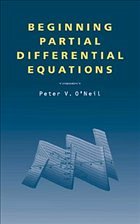Partielle Differentialgleichungen sind das mathematische Mittel zur Beschreibung der Geschwindigkeit von Veränderungen. Dieses weiterführende Lehrbuch geht zwar von den Grundbegriffen aus, richtet sich aber vorrangig an Doktoranden und Forscher mit gefestigtem mathematischen Hintergrundwissen, die auch abstraktere Aspekte des Themas verstehen und Hinweise zur Behandlung von Spezialfällen benötigen. Mit zahlreichen Übungsbeispielen. (04/99)
Beginning Partial Differential Equations provides a challenging yet accessible introduction to partial differential equations for advanced undergraduate and beginning graduate students. Features include:
* A discussion of first order equations and the method of characteristics for quasi-linear first order PDEs
* Canonical forms of second order PDEs
* Characteristics and the Cauchy problem
* A proof of the Cauchy-Kowalevski theorem for linear systems
* A self-contained development of tools from Fourier analysis
* Connections between the mathematics and physical interpretations of PDEs
* Numerous exercises, many with solutions provided
* Experimental, computer-based exercises designed to develop lines of inquiry.
The treatment of second order PDEs focuses on well-posed problems, properties and behavior of solutions, existence and uniqueness of solutions, and techniques for writing representations of solutions. Techniques include the use of characteristics, Fourier methods, and, for the Dirichlet problem, Green's function and conformal mappings. Also included are the Kirchhoff/Poisson solution of the wave equation, Huygens's principle, and Lebesgue's example of a Dirichlet problem with no solution.
"It is a good book. It is a tract written by a pure mathematician for a fairly advanced audience. If you teach at Podunk U. and you think you are going to use this text to teach junior engineering students. . .then you had better think again: Read the book first." (The UMAP Journal Vol. 21, No. 2 Summer 2000)
The book gives an easy manipulative treatment of the subject with applications rather than a rigorous and systematic theory.... It can be used as a text book at a senior undergraduate and / or first-year graduate level course in mathematics, science and engineering. (Zentralblatt Math, Volume 938, No 13, 2000)
First Order Partial Differential Equations.
Linear Second Order Partial Differential Equations.
Elements of Fourier Analysis.
The Wave Equation.
The Heat Equation.
Dirichlet and Neumann Problems.
Conclusion.
Index.
Beginning Partial Differential Equations provides a challenging yet accessible introduction to partial differential equations for advanced undergraduate and beginning graduate students. Features include:
* A discussion of first order equations and the method of characteristics for quasi-linear first order PDEs
* Canonical forms of second order PDEs
* Characteristics and the Cauchy problem
* A proof of the Cauchy-Kowalevski theorem for linear systems
* A self-contained development of tools from Fourier analysis
* Connections between the mathematics and physical interpretations of PDEs
* Numerous exercises, many with solutions provided
* Experimental, computer-based exercises designed to develop lines of inquiry.
The treatment of second order PDEs focuses on well-posed problems, properties and behavior of solutions, existence and uniqueness of solutions, and techniques for writing representations of solutions. Techniques include the use of characteristics, Fourier methods, and, for the Dirichlet problem, Green's function and conformal mappings. Also included are the Kirchhoff/Poisson solution of the wave equation, Huygens's principle, and Lebesgue's example of a Dirichlet problem with no solution.
"It is a good book. It is a tract written by a pure mathematician for a fairly advanced audience. If you teach at Podunk U. and you think you are going to use this text to teach junior engineering students. . .then you had better think again: Read the book first." (The UMAP Journal Vol. 21, No. 2 Summer 2000)
The book gives an easy manipulative treatment of the subject with applications rather than a rigorous and systematic theory.... It can be used as a text book at a senior undergraduate and / or first-year graduate level course in mathematics, science and engineering. (Zentralblatt Math, Volume 938, No 13, 2000)
First Order Partial Differential Equations.
Linear Second Order Partial Differential Equations.
Elements of Fourier Analysis.
The Wave Equation.
The Heat Equation.
Dirichlet and Neumann Problems.
Conclusion.
Index.
"The book gives an easy manipulative treatment of the subject with applications rather than a rigorous and systematic theory." (Zentralblatt Math, Volume 938, No 13, 2000)
"It is a good book. It is a tract written by a pure mathematician for a fairly advanced audience." (The UMAP Journal, Vol. 21, No. 2, Summer 2000)
"It is a good book. It is a tract written by a pure mathematician for a fairly advanced audience." (The UMAP Journal, Vol. 21, No. 2, Summer 2000)

